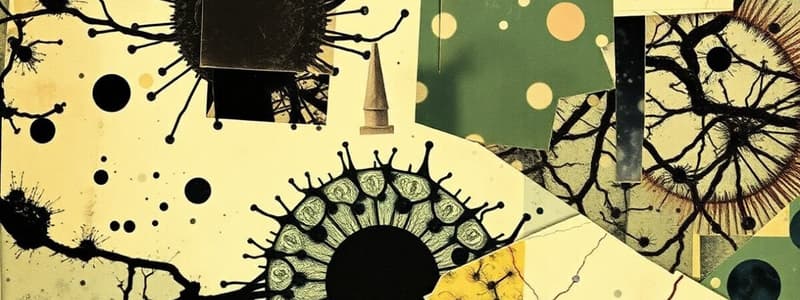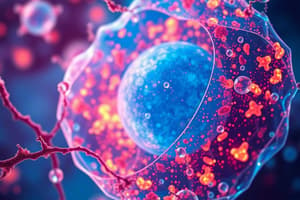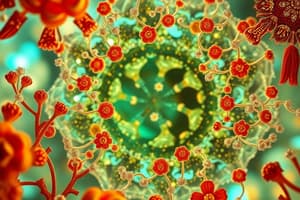Podcast
Questions and Answers
What is the main structural component of plant cell walls?
What is the main structural component of plant cell walls?
- Chitin
- Starch
- Cellulose (correct)
- Lignin
What is the role of plasmodesmata in plant cells?
What is the role of plasmodesmata in plant cells?
- They provide rigid support to the cell.
- They serve as the primary site for photosynthesis.
- They allow communication and transport between adjacent cells. (correct)
- They act as storage for nutrients and waste.
Which of the following organelles is responsible for ribosome production?
Which of the following organelles is responsible for ribosome production?
- Nucleus (correct)
- Vacuole
- Mitochondria
- Endoplasmic Reticulum
What does the fluid mosaic model describe?
What does the fluid mosaic model describe?
What is formed by the thickening of primary walls in plant cells?
What is formed by the thickening of primary walls in plant cells?
What is the function of the endoplasmic reticulum (ER) in eukaryotic cells?
What is the function of the endoplasmic reticulum (ER) in eukaryotic cells?
What defines prokaryotic cells in contrast to eukaryotic cells?
What defines prokaryotic cells in contrast to eukaryotic cells?
What are the primary components of the cytoplasm?
What are the primary components of the cytoplasm?
What is the primary function of the rough endoplasmic reticulum (ER)?
What is the primary function of the rough endoplasmic reticulum (ER)?
What role do ribosomes play in cellular function?
What role do ribosomes play in cellular function?
Which of the following best describes the function of dictyosomes (Golgi bodies)?
Which of the following best describes the function of dictyosomes (Golgi bodies)?
What structures are found within chloroplasts that play a crucial role in photosynthesis?
What structures are found within chloroplasts that play a crucial role in photosynthesis?
Which type of plastid is responsible for synthesizing carotenoids?
Which type of plastid is responsible for synthesizing carotenoids?
What is the primary function of mitochondria within a cell?
What is the primary function of mitochondria within a cell?
Which of these statements about vacuoles is correct?
Which of these statements about vacuoles is correct?
What is the primary difference between prokaryotic and eukaryotic cells?
What is the primary difference between prokaryotic and eukaryotic cells?
Who is credited with the discovery of cells in 1665?
Who is credited with the discovery of cells in 1665?
What distinguishes microbodies from other organelles?
What distinguishes microbodies from other organelles?
Which type of microscope is capable of distinguishing organelles that are 2 micrometers or larger?
Which type of microscope is capable of distinguishing organelles that are 2 micrometers or larger?
What type of microscope uses a beam of electrons to magnify specimens?
What type of microscope uses a beam of electrons to magnify specimens?
Which of the following statements about cells is incorrect?
Which of the following statements about cells is incorrect?
What primary characteristic differentiates higher plant cells from animal cells?
What primary characteristic differentiates higher plant cells from animal cells?
What did Jean Baptiste de Lamarck assert in 1809 regarding cellular tissue?
What did Jean Baptiste de Lamarck assert in 1809 regarding cellular tissue?
What is the maximum magnification capability of transmission electron microscopes?
What is the maximum magnification capability of transmission electron microscopes?
What is the primary role of microtubules in the cytoskeleton?
What is the primary role of microtubules in the cytoskeleton?
Which phase occupies the majority of the cell cycle?
Which phase occupies the majority of the cell cycle?
During which stage of mitosis do chromosomes align at the cell's equator?
During which stage of mitosis do chromosomes align at the cell's equator?
What occurs to the nuclear envelope during prophase?
What occurs to the nuclear envelope during prophase?
What are chromatids called after they separate during anaphase?
What are chromatids called after they separate during anaphase?
What forms between daughter cell nuclei during cell division?
What forms between daughter cell nuclei during cell division?
What is the first major event in prophase during mitosis?
What is the first major event in prophase during mitosis?
What is produced during the G2 phase of the cell cycle?
What is produced during the G2 phase of the cell cycle?
Flashcards are hidden until you start studying
Study Notes
Introduction to Cells
- Cells are the fundamental units of life, with all living organisms originating from a single cell.
- Differentiation in cells leads to variations in structure and function.
- Common features shared by all cells include plasma membrane, cytoplasm, and genetic material.
History of Cell Discovery
- 1665: Discovery of cells by Robert Hooke.
- 1670s: Marcello Malpighi and Nehemiah Grew observe single-celled organisms, calling them “animacules.”
- 1809: Jean Baptiste de Lamarck emphasizes the significance of cellular tissue for life.
Modern Microscopes
- Light Microscopes: Utilize light to magnify objects; can resolve organelles ≥2 micrometers.
- Types include compound and dissecting (stereomicroscopes).
- Electron Microscopes: Employ electron beams for higher magnification.
- Transmission microscopes can achieve up to 200,000x magnification (requires thin specimen).
- Scanning microscopes provide surface details at up to 10,000x magnification.
Eukaryotic vs. Prokaryotic Cells
- Prokaryotic Cells: Lack a nucleus and membrane-bound organelles; primarily represented by bacteria.
- Eukaryotic Cells: Contain a nucleus; include unicellular organisms, fungi, plants, and animals; have membrane-bound organelles.
Cell Structure and Communication
- The Cell Wall: Surrounds plasma membrane; composed mainly of cellulose microfibrils.
- Plasma Membrane: A semipermeable boundary controlling substance movement, made of a phospholipid bilayer and proteins, following the fluid mosaic model.
- Cytoplasm: The area between the plasma membrane and nucleus, containing cytosol and organelles.
- Communication: Plasmodesmata allow fluid and substance transfer between adjacent cells.
Cellular Components
- Nucleus: Control center with DNA; surrounded by a nuclear envelope with pores and nucleoli for ribosome production.
- Endoplasmic Reticulum (ER): A network of membranes; Rough ER is involved in protein synthesis, while Smooth ER aids lipid synthesis.
- Ribosomes: Synthesize proteins; found on Rough ER or freely in the cytoplasm.
- Dictyosomes (Golgi Bodies): Modify and package proteins; assemble polysaccharides.
- Plastids: Include chloroplasts (site of photosynthesis), chromoplasts (color synthesis), and leucoplasts (storage of starches/oils).
- Mitochondria: Powerhouse of the cell; site of cellular respiration and ATP production.
- Microbodies: Contain specialized enzymes; peroxisomes and glyoxisomes assist in various metabolic pathways.
- Vacuoles: Large central vacuoles can occupy 90% of cell volume; involved in storage, pressure maintenance, and pH regulation.
- Cytoskeleton: Provides structural support; formed by microtubules which aid in cell movement and organelle transport.
Cellular Reproduction
- Cell Cycle: Comprises interphase and mitosis; interphase accounts for 90% of the cycle and involves growth and DNA replication.
- Mitosis: Produces two identical daughter cells, occurring in meristems; consists of prophase, metaphase, anaphase, and telophase.
- Prophase: Chromosomes condense; spindle fibers attach to kinetochores; nuclear envelope disintegrates.
- Metaphase: Chromosomes align at the spindle equator; centromeres prepare for separation.
- Anaphase: Sister chromatids are pulled to opposite poles; become daughter chromosomes.
- Telophase: Nuclear envelopes reform around daughter chromosomes; nucleoli reappear; spindle fibers disassemble.
- Cell Plate Formation: Phragmoplast formation leads to the creation of a cell plate, which fuses with the cell wall.
Studying That Suits You
Use AI to generate personalized quizzes and flashcards to suit your learning preferences.



